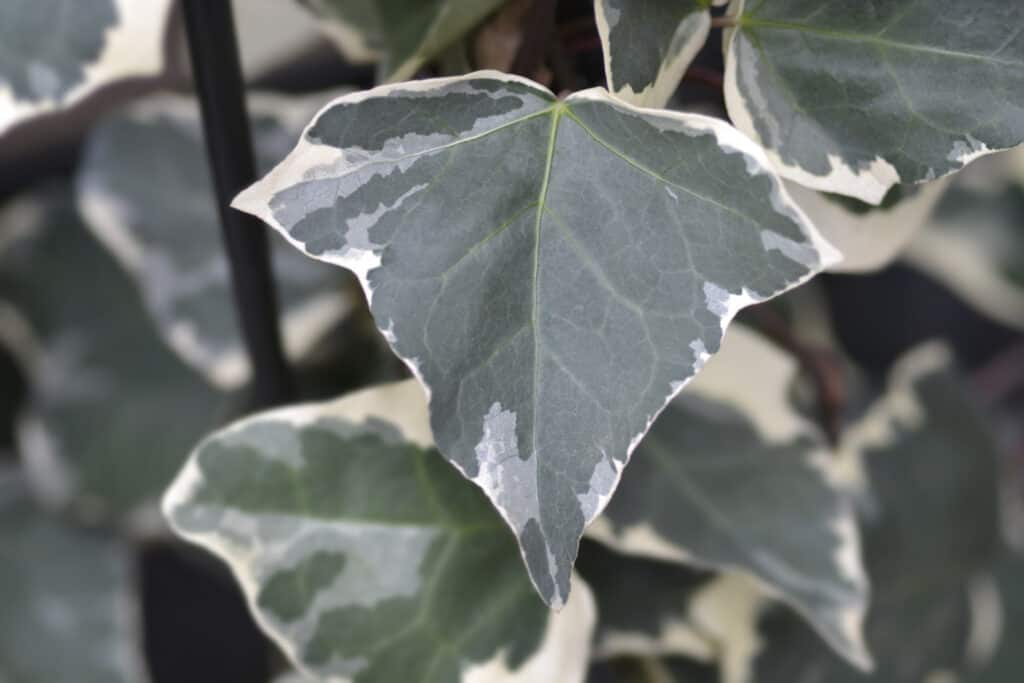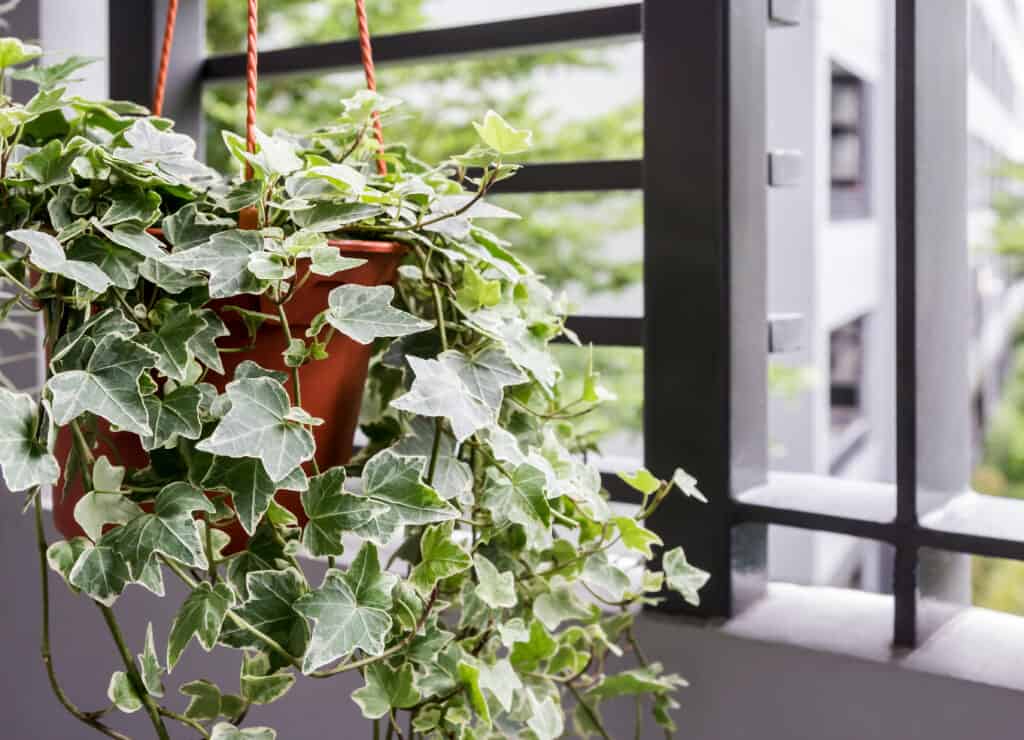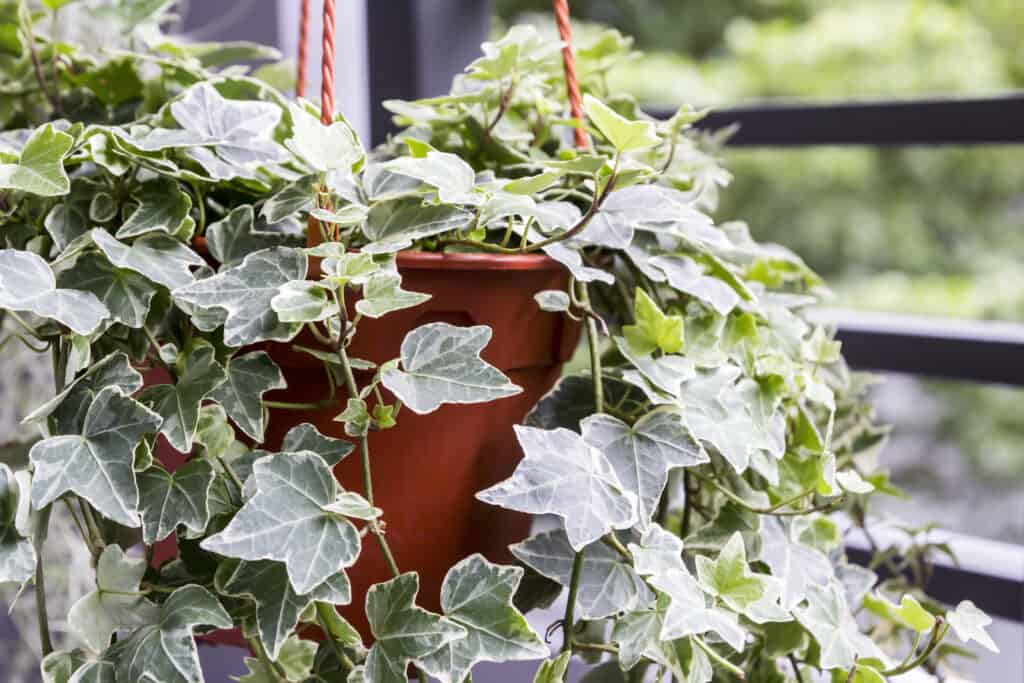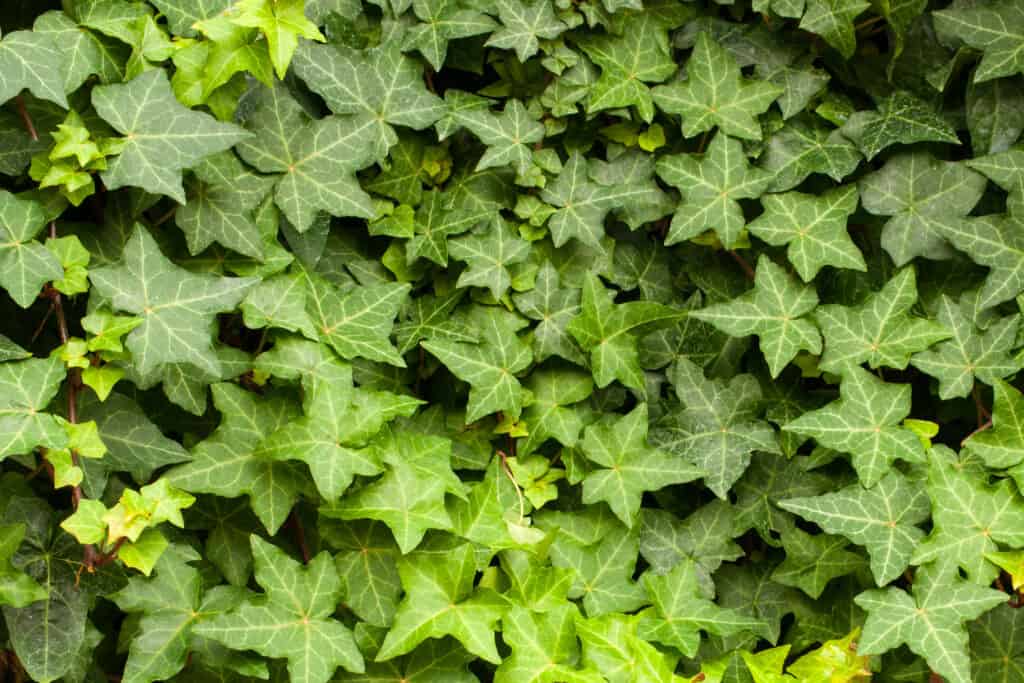Algerian Ivy and English Ivy are often mistaken for one another, especially because the leaves have similar shapes. Despite their similarities, there are key and noticeable differences. Within the ivy family, there are 12 to 15 distinct species of these woody plants. They are beautiful, grow tall, and spread quickly. While you may not know the differences between Algerian ivy and English ivy, you have likely seen both growing on the side of buildings and old cars.
Ready to learn more about these awesome plants? Keep on reading!
Comparing Algerian Ivy vs English Ivy

Algerian ivy flowers are umbrella-like and range from a pale yellow to whitish green.
©iStock.com/Nahhan
| Algerian Ivy | English Ivy | |
|---|---|---|
| Scientific Classification | Algerian Ivy belongs to the evergreen family. Its scientific name is hedera algeriensis. | English Ivy belongs to the evergreen family. Its scientific name is hedera helix. |
| Description | Algerian ivy leaves are often uniform, light green, and white/yellow. | The most common type of ivy. Uniform dark green leaves, heart and oval shaped. |
| Uses | Grows in the wild, but is also a very popular landscaping plant for shade. Sometimes grown as ground cover to prevent erosion. | Grows in the wild, but is also used as a landscaping plant. It climbs tall, sometimes surpassing 50 feet long. |
| Hardiness | Algerian ivy grows in USDA hardiness zones 7-11. | English ivy grows in USDA hardiness zones 4-13. |
| Origin | North Africa, specifically the coastal mountains in Algeria. | Europe, Northern Africa, and Western Asia. |
Key Differences Between Algerian Ivy vs English Ivy
The key differences between Algerian Ivy and English Ivy are flowers, description, uses, hardiness, and origin.
These plants have more similarities than differences. However, while they belong to the same family, the flowers and growth rate are not the same. Both plants can be kept indoors as houseplants if they have the right amount of water and light.
Algerian Ivy vs English Ivy: Flowers

English ivy flowers bloom green, white, or yellow.
©ArtBackground/Shutterstock.com
Ivy plants are mostly known for their vivid dark green leaves. However, did you know they also bloom and produce berries? Algerian ivy flowers are umbrella-like and range from a pale yellow to whitish green. Keep in mind that the fruit and flowers produced by Algerian ivy are toxic and should not be consumed. English ivy similarly produces umbrella-like flowers. The berries are dark blue and purple. English ivy flowers bloom green, white, or yellow. When English ivy produces flowers and berries, they bloom in large clusters.
Algerian Ivy vs English Ivy: Description

Some Algerian ivy plants are variegated.
©iStock.com/skymoon13
Algerian ivy plants are beautiful, thick, and vibrant. Its stems are reddish, and its leaves are a deep green. While most leaves appear similar, they differ in size, shape, and color. For example, some Algerian ivy plants are variegated. This means that its leaves vary in color with white tips or spots. Although Algerian ivy plants are often planted in the ground as a cover, they can still climb up 40 feet.
English Ivy looks quite different from Algerian ivy upon further inspection. For instance, English ivy plants have deep green leaves that are either heart-shaped or oval. They are often spotted climbing on trees, buildings, and brick walls up to 90 feet. They are woody vines with thick roots and stems. While they don’t always flower, when these plants do, they produce small bunches of yellow blossoms.
Algerian Ivy vs English Ivy: Uses

Some studies show that English ivy can lead to improved respiratory conditions.
©ArtBackground/Shutterstock.com
Although this section is titled ‘uses,’ that does not mean you should confidentially consume either plant. Actually, both Algerian and English ivy is toxic. However, you can use both ivy vines to improve air circulation and cleanliness. Some studies show that English ivy can lead to improved respiratory conditions.
While you can grow Algerian and English ivy indoors as houseplants, they regularly grow outside widely and as cover and decorations in front yards. Algerian ivy is used as a cover crop for most front and backyards. They grow really well on the ground and stretch, showing off the vine’s beautiful green and white leaves. English ivy is naturally common in forests, gardens, and urban locations but is sometimes grown to give a home a mystical or cottage-like look.
Algerian Ivy vs English Ivy: Hardiness

While it does require some sunlight, too much direct sun may stunt the growth of the vine of Algerian ivy
©iStock.com/Nadia AUDIGIE
Despite sharing a similar appearance, Algerian and English ivy does not grow in the same USDA zones. For example, Algerian ivy grows naturally in zones 7-11. While it does require some sunlight, too much direct sun may stunt the growth of the vine. It is not a cold hardy plant and may die or stay dormant during cold winters. It is best to bring the vine inside.
English ivy is a lot more versatile and not as picky. This type of vine grows in USDA zones 4-13. They bloom during Fall and can tolerate colder climates. English ivy plants love the shade and prefer growing away from direct sunlight. They are easy to grow indoors as well and don’t require frequent watering. Too much watering can easily lead to root rot, slowly killing the plant and leaving your home with a musky scent.
Algerian Ivy vs English Ivy: Origin

English ivy grows throughout North America as it was brought to the continent by European settlers in 1727 as a ‘low-maintenance’ cover crop.
©Kaytoo/Shutterstock.com
Although Algerian ivy and English ivy vines come from the same family and species, they grow in completely different places. The origin of the Algerian ivy is the coastal mountains in Algeria and other coastal parts of North Africa. While they originate only in those places, they grow well in North America as they are drought resistant. English Ivy, however, is found in Europe, Western Asia, and Northern Africa. It also grows throughout North America as it was brought to the continent by European settlers in 1727 as a ‘low-maintenance’ cover crop.
Up Next:
Boston Ivy vs English Ivy: What Are The Differences?
Canna Lily vs Calla Lily: What Are The Differences?
Elephant Bush vs Jade Plant: What Are The Differences?
https://www.healthline.com/health/5-fast-facts-english-ivy#how-to-use-it
The photo featured at the top of this post is ©
Thank you for reading! Have some feedback for us? Contact the AZ Animals editorial team.






